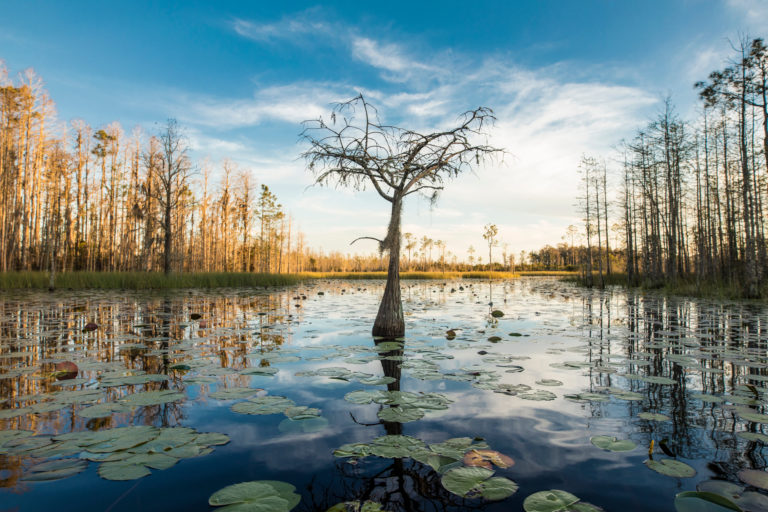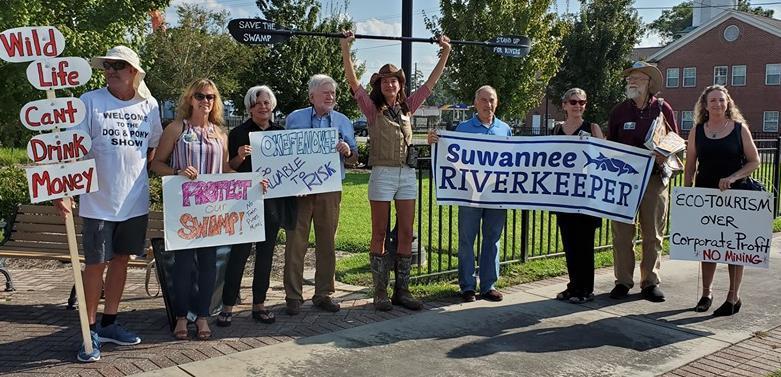Take Action: Protect Okefenokee Swamp from a Titanium Mine
By: Julia Widmann

Today, you can use your voice to help protect a beautiful blackwater swamp in southern Georgia and the surrounding community from the risk of dangerous mining pollution.
Okefenokee National Wildlife Refuge is home to the beloved blackwater Okefenokee Swamp, a Wetland of International Importance and a World Heritage Site. In 2019, Twin Pines, an Alabama-based company, first proposed a titanium mine beside the swamp.
Okefenokee Swamp is an ecologically diverse wetland, enjoyed by boaters and fishers as well as alligators and blue herons. The swamp is also an important tourist attraction that provides great economic benefits to the local area. The proposed mine poses dangerous risks to the water quality and the environment in and around the wetland, including the potential to disrupt groundwater flow and drain the swamp, and release polluted water into the swamp.
The swamp lies in the headwaters of the Suwannee and St. Marys Rivers in Southern Georgia, which means both of these rivers—which are home to endangered species like the Atlantic Sturgeon—and their downstream communities are also at great risk of pollution from the proposed mine.
However, because the land is owned by the federal government and is enjoyed by tourists from across the country, communities across the nation can help protect this natural resource. The Suwannee Riverkeeper and St. Marys Riverkeeper are already working closely with neighboring Waterkeepers and public interest and environmental groups, including Southern Environmental Law Center and Sierra Club. The coalition to protect Okefenokee Swamp includes partners across Georgia, Florida, and the rest of the country.

Public comments make a difference
In 1999, DuPont Co. tried to propose a mine in the same area beside Okefenokee Swamp but was thwarted by an outpouring of public opposition.
Twenty years later, in 2019, Twin Pines first proposed a titanium mine beside the swamp, but its first attempt was blocked, too. Countless public interest and environmental groups—including several Waterkeeper groups and Waterkeeper Alliance—voiced their opposition. Government agencies opposed the project, too. EPA Region 4 Administrator Mary Walker and officials from the U.S. Fish and Wildlife Service wrote letters of opposition in 2019, calling out the project’s “substantial risk” to the environment.
This year, Twin Pines withdrew their first application and resubmitted another, for a slightly smaller land area. Public interest groups continue to highlight the potential risk of the project under the new application and are pushing for an Environmental Impact Statement, which is a much more thorough and detailed assessment with more opportunity for public engagement than the analysis that Twin Pines is currently completing. It’s up to the Army Corps to require a more complete Environmental Impact Statement.
Today, another wave of public outcry is needed to ensure that Twin Pines’ project does not move forward without an Environmental Impact Statement that fully assesses the risks to Okefenokee Swamp and the Suwannee and St. Marys rivers. Please join us in protecting this national treasure by filing your comment to the Army Corps by May 28, 2020.
How to help
Send comments by the deadline of May 28, 2020, below:
Feature image of Okefenokee Swamp by John Wollwerth/Shutterstock.